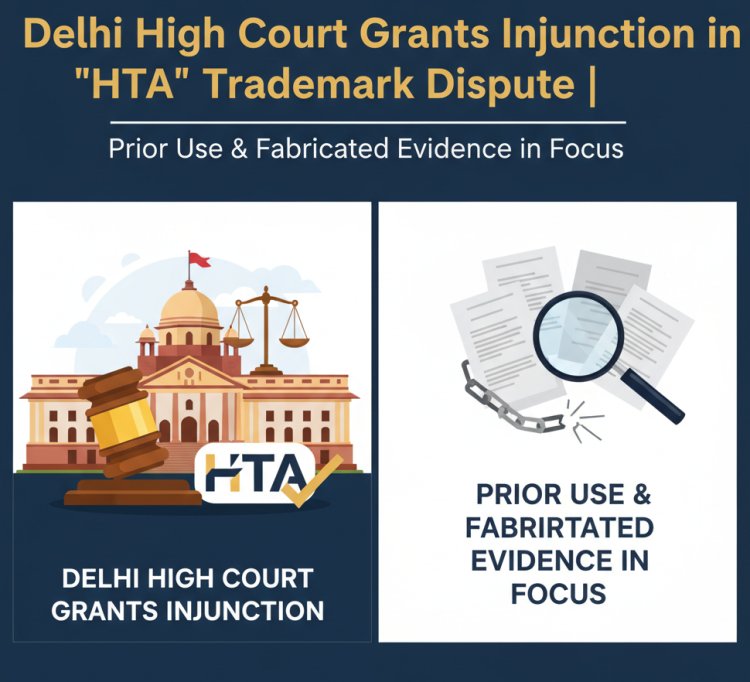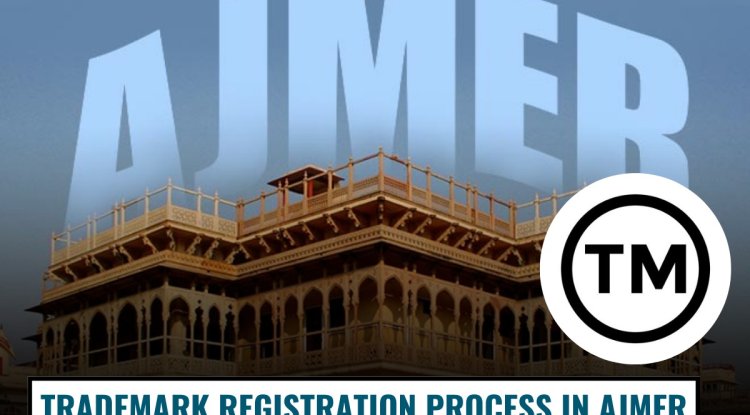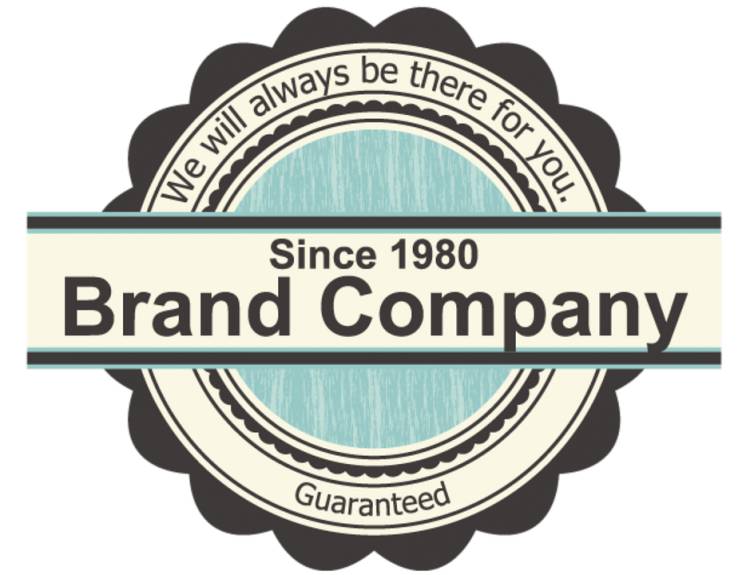Delhi High Court Grants Injunction in 'HTA' Trademark Dispute | Prior Use & Fabricated Evidence in Focus
The Delhi High Court, in Hi Tech Arai Pvt. Ltd. v. Paul Components Pvt. Ltd., granted an injunction over the ‘HTA’ mark, stressing the importance of genuine prior use and exposing fabricated evidence. This ruling reinforces honesty and fair play in trademark law.

Introduction
In a significant ruling delivered on September 9, 2025, the Delhi High Court addressed an important case, Hi Tech Arai Private Limited v. Paul Components Private Limited & Ors. (CS(COMM) 891/2023). The court upheld the rights of the original user against those who sought to adopt their mark unfairly. As a result, the plaintiffs, Hi Tech Arai Pvt. Ltd., were granted an interim injunction that prevents the defendants from using the mark “HTA,” or any logos or trade dress that closely resemble theirs. This decision highlights the critical role of genuine adoption, prior use, and the importance of documentary evidence in intellectual property disputes, reinforcing the protections available to businesses that invest in their brands.
Factual Background
Hi Tech Arai Private Limited is a well-established company in the automobile industry, known for its innovative rubber and aluminum die-casting products. Originally founded in 1985 as Hi-Tech Ancillaries Private Limited, the company entered a fruitful partnership with Arai Seisakusho Co. Ltd. and Mitsubishi Corporation from Japan, which led to the adoption of the marks ‘HTA’ and ‘Ars-HTA’, along with some unique logos, in the 1990s. However, a dispute arose with Paul Components Private Limited and others, who claimed to have used the ‘HTA’ mark since 1977 through their predecessor, M/s Paul & Paul, and presented several trademark registrations to back their ownership claim. In response to instances of imitation and misrepresentation, Hi Tech Arai filed a lawsuit seeking a permanent injunction and highlighting concerns that the defendants had falsified documents and manipulated evidence to support their claims of prior use.
Significance of Ruling
This case highlights the importance of credible evidence in intellectual property disputes. The court meticulously evaluated the timeline of trademark usage and underscored the significance of authentic historical use over alleged inception claims lacking substantiation.
Additionally, the judgment reinforces the judiciary's stance on discouraging fraudulent practices in asserting trademark rights. By granting an injunction, the court not only protected the plaintiff's brand equity but also set a precedent emphasizing the necessity of clean hands in trademark litigation.
Plaintiff’s Contentions
In this case, the plaintiff, represented by Mr. Aditya Gupta, firmly contended that the trademark “HTA” has been in continuous use since 1985, and this claim is backed by extensive documentary evidence. They argued that the defendants went so far as to fabricate invoices, brochures, and photographs to falsely suggest they had prior use of the mark dating back to 1977. The plaintiff pointed out a troubling pattern in the defendants' behavior, noting their multiple applications for third-party trademarks like JCB, Cummins, Hino Prime, and Meritor, which indicates bad faith. Furthermore, the plaintiff highlighted that the trade dress and packaging used by the defendants closely resembled their own, creating confusion among consumers.
Defendants’ Contentions
Senior Counsel Mr. C.M. Lall made several important points regarding the case. He highlighted that the mark “HTA” has been a coined term used by the defendants’ predecessor since 1977. Additionally, he pointed out that the defendants hold registered trademarks in Classes 12 and 17. Importantly, he noted that the plaintiff's use of “HTA” has been limited to internal reference codes and not utilized as a trademark in the marketplace. Lastly, Mr. Lall referenced an earlier judgment in CS(COMM) 374/2023, which supports the defendants' claim of prior use, emphasizing the strength of their position in this matter.
Issues For Determination
In this case, there are several important issues to discuss. First, we need to determine who was the prior adopter and user of the mark “HTA.” Next, it’s essential to consider whether the defendants have fabricated or manipulated any documents to mislead the Court. Additionally, we must assess whether the plaintiff has established a prima facie case of passing off. Finally, we will need to decide if an interim injunction should be granted in favor of the plaintiff. Each of these points will help us navigate the case effectively.
Court’s Analysis and Findings
A. Prior User Evidence
In the court's analysis, the judge recognized that the plaintiff had provided substantial evidence of the continuous use of the "HTA" mark since 1985. This included technical drawings from 1985, invoices from 1986, and advertising materials from 1997. The court referred to Section 29(6)(d) of the Trade Marks Act, 1999, affirming that using a mark on invoices and other business documents qualifies as trademark use. The plaintiff's impressive commercial presence, with 20 lakh products supplied daily and an annual turnover of ₹600 crores for the fiscal year 2022-23, further bolstered its claim to goodwill.
B. Defendants’ Trademark Registrations
|
S.NO |
TRADEMARK |
APPLICATION NO. |
CLASS |
USER DETAIL |
STATUS |
|
1 |
HTA (Word Mark) |
1589696 |
12 |
04.05.1994 |
Registered |
|
2 |
HTA Device Mark) |
4104095 |
17 |
04.05.1994 |
Registered |
|
3 |
HTA (Word Mark) |
4363318 |
17 |
04.05.1994 |
Registered |
|
4 |
HTA (Word Mark) |
5667622 |
17 |
25.01.1977 |
Registered |
The Court noted that the user claim changed from 1994 to 1977 in later filings, indicating manipulation to outdate the plaintiff’s adoption of the mark.
B. Fabricated Evidence
In the case known as "Fabricated Evidence," the Court uncovered several instances of manipulation by the defendants. For instance, photographs from trade fairs had been digitally altered to replace the name "Paul Components" with "HTA." Additionally, brochures from 2004 featured mobile numbers that began with an "8," a number format that only came into existence after 2009. Moreover, there were misleading references in Auto Expo brochures regarding editions that never actually took place in those years. These findings highlight serious concerns about the integrity of the evidence presented.
To know more about this you can follow the link below:
Table: Auto Expo Misrepresentation
|
Actual Year |
Correct Edition |
Claimed by Defendant |
|
2004 |
7th Edition |
8th Auto Expo 2004 |
|
2010 |
10th Edition |
10th Auto Expo 2008 |
|
2018 |
14th Edition |
14th Auto Expo 2018 |
|
2020 |
15th Edition |
14th Auto Expo 2020 |
The Court held that these materials were post-facto fabrications intended to create an artificial history of use.
Dishonest Conduct and Third-Party Trademark Filings
The Court highlighted that the defendants had applied for multiple marks belonging to renowned global brands, demonstrating a pattern of dishonest adoption.
Table: Third-Party Marks Applied by Defendants
|
Application No. / User Claim |
Trademark |
Goods |
Original Owner |
|
5982725 (Proposed to be used) |
JCB |
Oil seals & parts |
JC Bamford Excavators Ltd. |
|
5982726 (Proposed to be used) |
CUMMINS |
Oil seals & parts |
Cummins Inc. |
|
5433624 (Nov 2, 2010) |
HINO PRIME |
Rubber parts, sealing components |
Hino Motors Ltd. |
|
5843178 (May 4, 1994) |
MERITOR |
Oil seals, rubber mounts |
Meritor Inc. |
|
5843179 (May 4, 1994) |
MERITOR |
Rubber molded parts |
Meritor Inc. |
Judgment
In a recent ruling, the Court determined that the plaintiff was the original user of the mark "HTA." It found that the defendants' documents were unreliable and appeared to be fabricated, reflecting a lack of good faith and a clear intent to mislead both consumers and the Court. As a result, an interim injunction was granted. This means that the defendants, along with their agents and distributors, are now prohibited from using "HTA" or any similar marks as a word or logo. They are also restricted from using logos featuring concentric rings that closely resemble the plaintiff's and from employing trade dress or packaging that is identical to that of the plaintiff’s inner and outer boxes.
Conclusion
The conclusion of this judgment marks a significant milestone in the realm of trademark litigation, especially concerning dishonest adoption and the fabrication of evidence. Justice Amit Bansal’s ruling emphasizes a crucial principle: genuine prior use of a trademark takes precedence over mere registration. This insight is particularly vital for ensuring fairness in the marketplace. The judgment also serves as a strong warning against those who attempt to manipulate evidence to secure an unfair advantage. The Court’s firm stance underscores its intolerance for bad faith tactics, promoting integrity and honesty within intellectual property disputes. Overall, this ruling not only helps clarify legal standards but also reinforces the importance of ethical practices in business.












